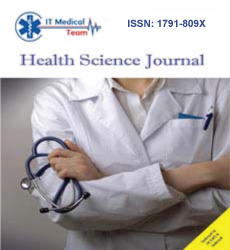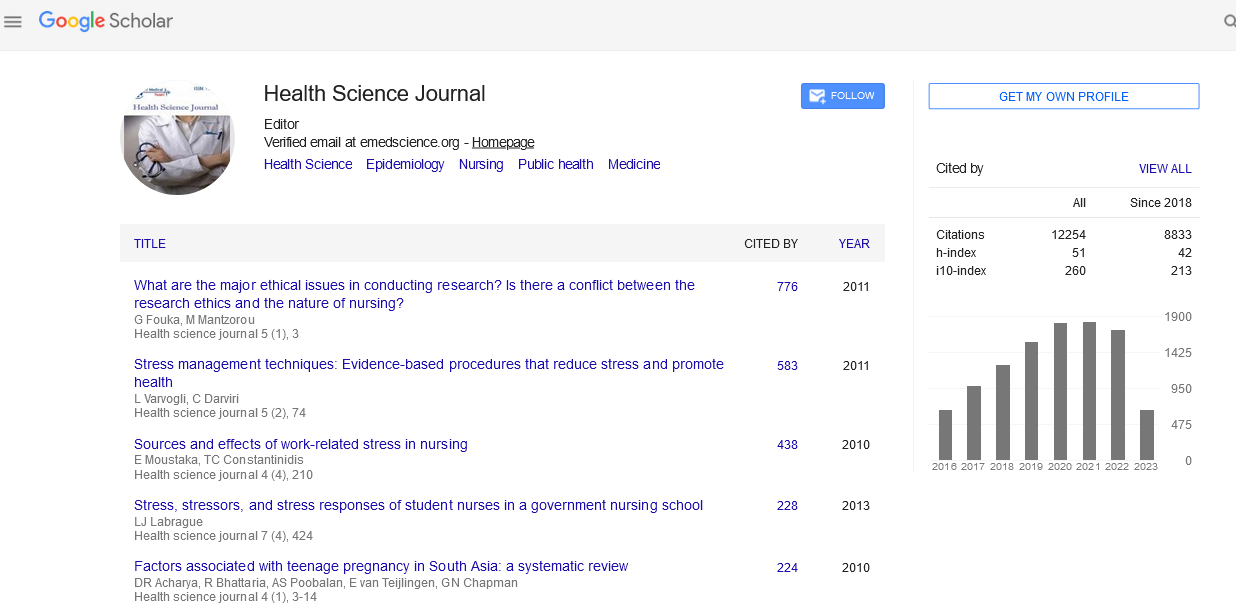Editorial - (2025) Volume 19, Issue 1
Longitudinal Analysis of Neuroplasticity Following Stroke Rehabilitation: The Role of Physical Therapy and Cognitive Training
Emily Rose Johnson*
1Department of Health Science, Charite Medical University of Berlin, Germany
*Correspondence:
Emily Rose Johnson, Department of Health Science, Charite Medical University of Berlin,
Germany,
Email:
Received: 01-Jan-2025, Manuscript No. Iphsj-25-15519;
Editor assigned: 04-Jan-2025, Pre QC No. Iphsj-25-15519 (PQ);
Reviewed: 16-Jan-2025, QC No. Iphsj-25-15519;
Revised: 21-Jan-2025, Manuscript No. Iphsj-25-15519 (R);
Published:
30-Jan-2025, DOI: 10.36648/1791-809X.19.1.1220
Introduction
Stroke remains one of the leading causes of disability worldwide, resulting in a range of motor, cognitive, and sensory impairments that significantly affect an individual's ability to perform daily activities [1]. Recovery following stroke can be a prolonged process, with many patients experiencing persistent deficits despite receiving rehabilitation. The concept of neuroplasticity—the brain's ability to reorganize and form new neural connections—has gained increasing attention in stroke rehabilitation. Neuroplasticity plays a critical role in the recovery of lost functions, and recent studies suggest that specific rehabilitation interventions, including physical therapy (PT) and cognitive training, may influence this process [2]. This article presents a longitudinal analysis of neuroplasticity following stroke rehabilitation, focusing on the role of physical therapy and cognitive training in enhancing functional recovery and driving neural reorganization [3].
Neuroplasticity and Stroke Recovery
Following a stroke, the brain undergoes significant structural and functional changes. The initial damage caused by the ischemic event or hemorrhage leads to the loss of neurons and the disruption of neural networks in the affected regions. However, the brain also has the capacity to compensate for this damage through neuroplasticity, which involves the rewiring of existing neural circuits and the recruitment of alternative pathways to restore function. Neuroplasticity is a dynamic and ongoing process that can be influenced by various factors, including the timing of rehabilitation interventions, the intensity of therapy, and the individual’s engagement and motivation. The potential for neuroplasticity following stroke is greatest in the acute and subacute phases of recovery, but it is not confined to these early stages. Even in chronic stroke survivors, neuroplasticity remains a viable mechanism for recovery, though the brain’s ability to reorganize tends to decrease with time. It is now widely recognized that rehabilitation strategies that target both motor and cognitive functions can facilitate neuroplastic changes in the brain, enhancing recovery and improving long-term outcomes [4].
The Role of Physical Therapy in Neuroplasticity
Physical therapy (PT) has long been a cornerstone of stroke rehabilitation, focusing on improving motor function and restoring mobility. PT typically involves exercises aimed at strengthening muscles, improving coordination, and enhancing balance, with the goal of enabling patients to regain independence in their daily activities. More recently, research has emphasized the neuroplastic effects of PT, particularly in relation to how motor training can drive cortical reorganization in the brain. Studies have shown that intensive and task-specific PT interventions can induce changes in the motor cortex [5], leading to functional recovery in the affected limb or other motor systems. These changes are thought to occur through processes such as synaptogenesis (the formation of new synapses), dendritic growth, and the recruitment of motor areas that were not originally involved in the execution of a specific movement. High-intensity training, as well as repetitive practice of functional movements, is particularly effective in promoting neuroplasticity. Furthermore, interventions that target the affected side of the body while simultaneously encouraging bilateral movements have been found to promote interhemispheric communication, which can aid in motor recovery. In addition to traditional PT, newer approaches, such as constraint-induced movement therapy (CIMT) and robotic-assisted rehabilitation, have demonstrated the ability to enhance neuroplasticity by intensifying the motor training process. CIMT involves restraining the unaffected limb to encourage the use of the affected limb, thereby promoting neural adaptation in the damaged hemisphere. Robotic-assisted therapy allows for highly repetitive, controlled, and task-specific exercises that can be precisely tailored to the patient’s needs, facilitating optimal motor recovery and cortical reorganization [6].
The Role of Cognitive Training in Neuroplasticity
While physical rehabilitation is crucial for restoring motor function following stroke, cognitive impairments are common in stroke survivors and can significantly impact overall recovery. Cognitive deficits, including problems with attention, memory, executive function, and language, often co-occur with motor deficits and can hinder a person’s ability to engage in rehabilitation and daily activities. Cognitive training, therefore, plays an essential role in the holistic rehabilitation of stroke patients. Cognitive training typically involves structured exercises designed to improve specific cognitive domains, such as attention, memory, or problem-solving skills. These exercises often require active engagement from patients and can be delivered through computer-based programs, therapist-led sessions, or a combination of both. The aim of cognitive training is to stimulate neuroplastic changes in the brain, particularly in areas associated with higher-order cognitive functions. One of the key mechanisms through which cognitive training promotes neuroplasticity is the strengthening of synaptic connections in the brain regions involved in cognitive processing. Studies have shown that cognitive training following stroke can lead to improvements in both the targeted cognitive domain and overall functional abilities. For example, training aimed at improving attention has been associated with enhanced executive function and the ability to perform complex tasks. Similarly, memory training can result in improved recall and the ability to process new information. Functional magnetic resonance imaging (fMRI) studies have demonstrated that cognitive training leads to increased activation in brain regions that are responsible for memory, attention, and other cognitive functions, suggesting that the brain is reorganizing to compensate for the damage caused by the stroke. Moreover, recent research has highlighted the potential synergistic effects of combining physical therapy and cognitive training. When both motor and cognitive rehabilitation are integrated, patients may experience enhanced neuroplasticity in both motor and cognitive brain regions. This integrated approach can improve the efficiency of rehabilitation, leading to better overall outcomes in terms of both physical function and cognitive abilities.
Longitudinal Insights into Neuroplasticity and Rehabilitation
A longitudinal analysis of neuroplasticity in stroke rehabilitation offers important insights into how the brain adapts over time and the long-term effects of rehabilitation interventions. Longitudinal studies track changes in brain structure and function over extended periods, allowing researchers to assess the durability of neuroplastic changes induced by rehabilitation. One key finding from longitudinal research is that the benefits of rehabilitation can be sustained over time, provided that therapy is continued or periodically intensified. For instance, some studies have shown that the positive effects of PT and cognitive training can persist long after formal rehabilitation has ended, suggesting that neuroplastic changes may become ingrained in the brain’s functioning. However, this effect is contingent upon the continued practice of learned motor and cognitive skills, as well as the patient’s active participation in rehabilitation.
Another important aspect of longitudinal studies is the identification of critical time windows during which neuroplasticity is most pronounced. Research has shown that earlier rehabilitation, especially in the subacute phase following stroke, is associated with more substantial neuroplastic changes. However, it is also evident that neuroplasticity continues to occur in chronic stroke survivors, albeit at a slower rate. Longitudinal analyses help clarify the timing and intensity of interventions necessary to maximize recovery at different stages of rehabilitation.
Conclusion
Neuroplasticity is a fundamental process in the recovery of stroke patients, enabling the brain to reorganize and compensate for lost functions. Physical therapy and cognitive training both play essential roles in stimulating neuroplastic changes and enhancing recovery following stroke. High-intensity, task-specific motor training can induce reorganization in the motor cortex, while cognitive training can promote recovery in areas associated with attention, memory, and executive function. Longitudinal studies underscore the importance of early and sustained rehabilitation, as well as the need for integrated approaches that address both motor and cognitive deficits. As research continues to elucidate the mechanisms of neuroplasticity and the factors that influence recovery, stroke rehabilitation strategies will continue to evolve, offering hope for improved outcomes and quality of life for stroke survivors.
References
- Cleveland S, Kaare M, Tiringa P, Mlengeya T, Barrat J (2003) A dog rabies vaccination campaign in rural Africa: impact on the incidence of dog rabies and human dog-bite injuries. Vaccine 21: 1965-1973.
Indexed at, Google Scholar, Crossref
- Collier L, Oxford J (2006) Human Virology. 3rd ed. Oxford University Press Inc New York, USA. 189-194.
Google Scholar
- Constable DP, Hinchcliff WK, Done SH, Grunberg W (2017) Veterinary Medicine A Textbook of the Diseases of Cattle, Horses, Sheep, Pigs, and Goats. 11th ed. Elsevier Missouri USA 1228-1238.
Google Scholar
- Abebe A (2012) Major challenges and gaps in rabies prevention and control. In Proceedings of the national workshop on rabies prevention and control in Ethiopia. 18-19.
Indexed at, Google Scholar
- Aga AM, Hurisa B, Urga K (2016) Current situation of rabies prevention and control in developing countries: Ethiopia perspective. Infectious Prev Med Infect Dis 4: 1-6.
Indexed at, Google Scholar, Crossref
- Ali A, Mengistu F, Hussen K, Getahun G, Deressa A (2010) Overview of rabies in and around Addis Ababa, in animals examined in EHNRI zoonoses laboratory between, 2003 and 2009. Ethiop Vet J 1491-1501.
Indexed at, Google Scholar, Crossref
Citation: Johnson ER (2024) Longitudinal Analysis of Neuroplasticity Following Stroke Rehabilitation the Role of Physical Therapy and Cognitive Training. Health Sci J. Vol. 19 No. 1: 1220.





